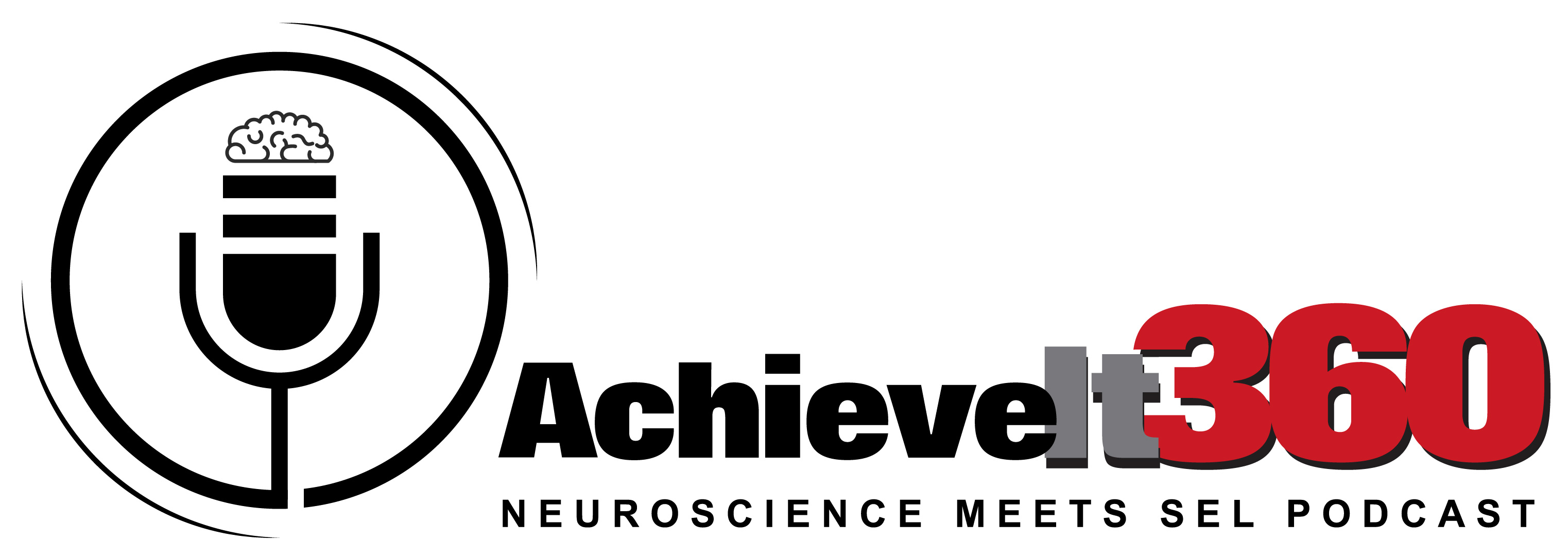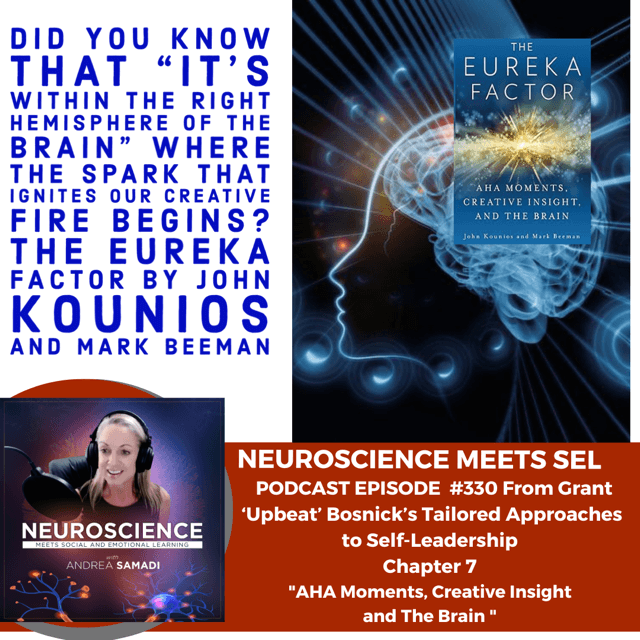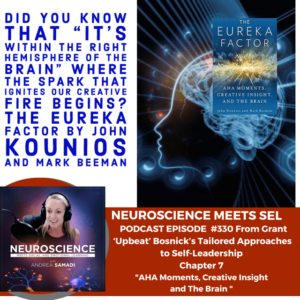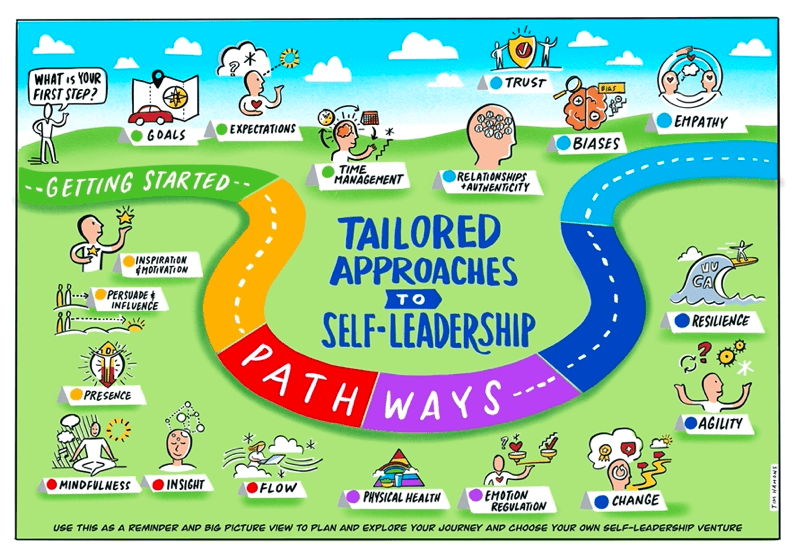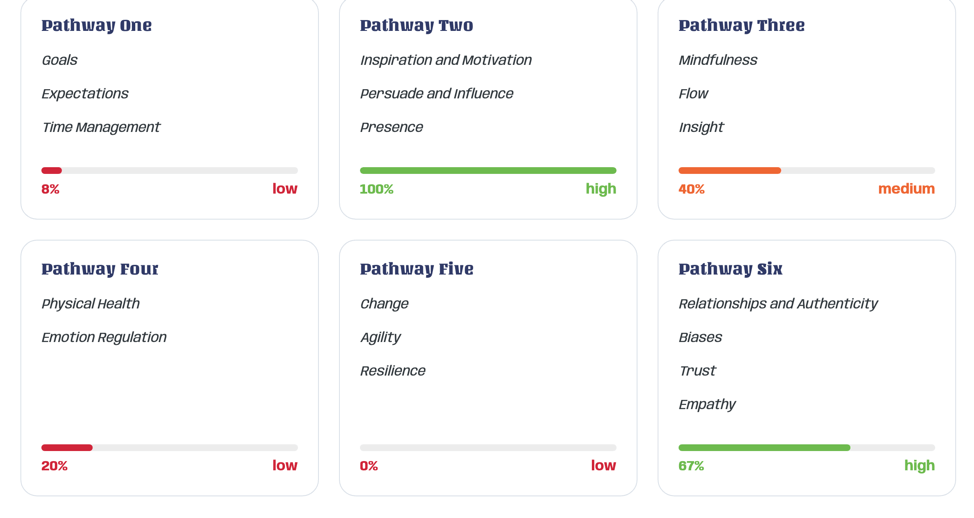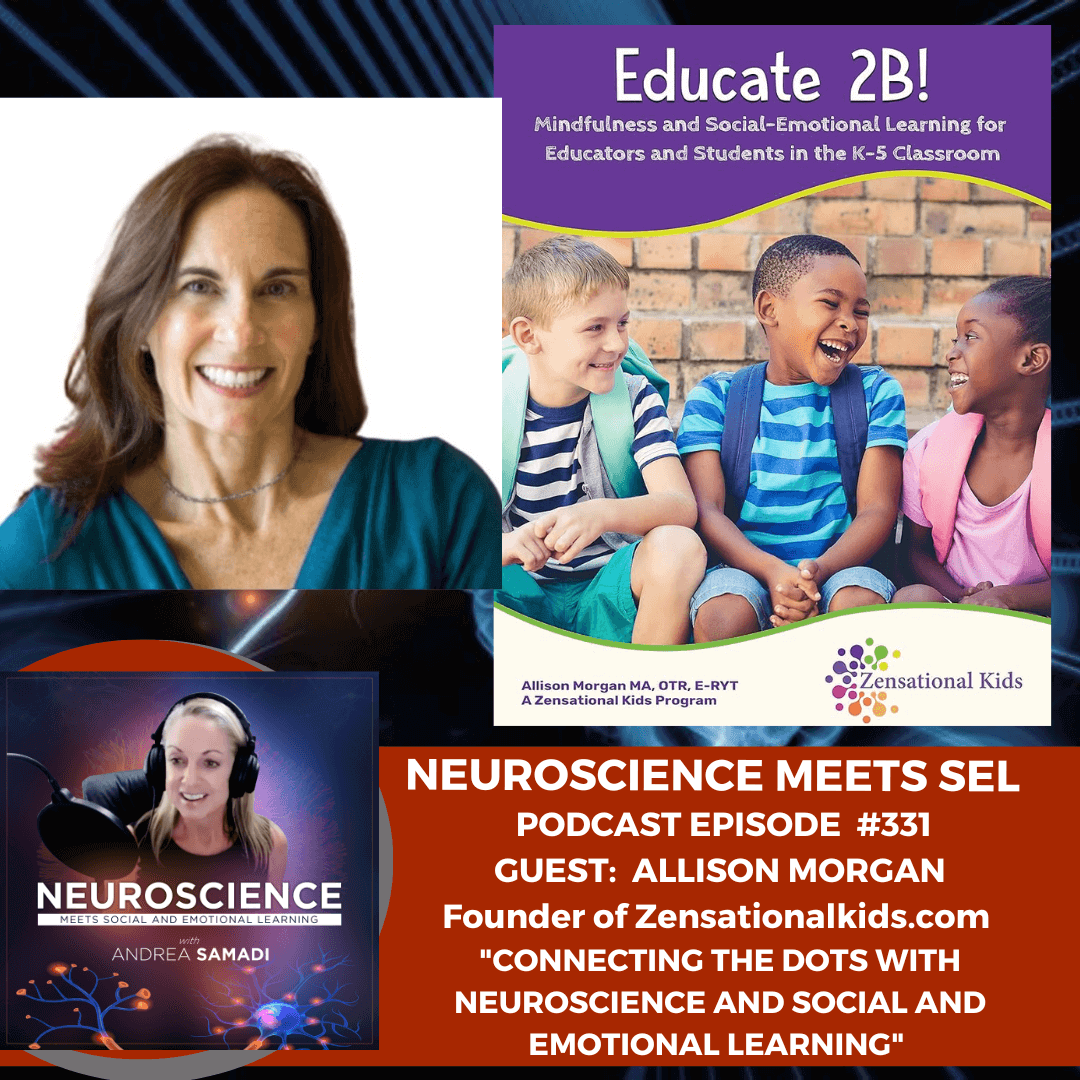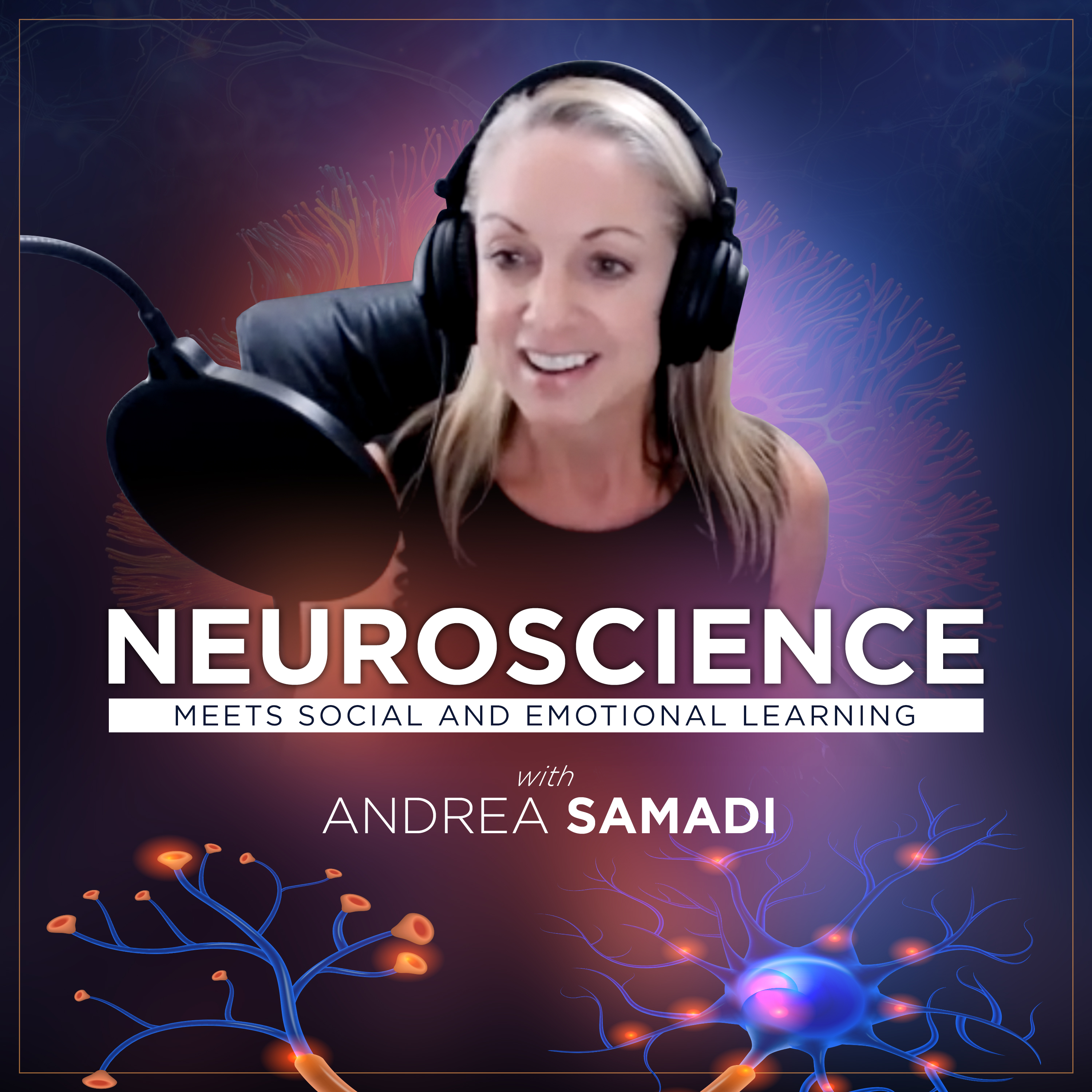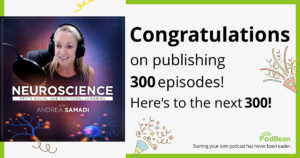Welcome to Episode 330 of the Neuroscience Meets Social and Emotional Learning Podcast, a part of our 18-week series on self-leadership. Join host Andrea Samadi and author Grant Bosnick as they explore the neuroscience theory behind creating solid health habits, establishing goals, and increasing productivity for greater achievement and well-being.
Tap into the power of the AHA moment, and learn how to foster these spontaneous occurrences for instant performance improvement. Bosnick shares insights from his book “Tailored Approaches to Self-Leadership” and offers strategies for organizations to solve problems creatively using innovative thought processes.
Uncover the crucial role physical and mental health play, particularly the significance of adequate hydration for brain health and daily water intake recommendations. Learn about the concept of neuroplasticity and see examples of creative problem solving applied in real-life situations.
Listen as we bring to light interesting perspectives from Professor Hod Lipson from Columbia University on AI and innovation, discuss the Silva Method, and recall our first series on creativity and innovation. Take inspiration from figures like Albert Einstein and learn about hypnosis from the work of Dr. David Spiegel. Cultivate self-awareness and personally tailored plans using our practical five-step method to foster more ‘aha’ moments. Experience the magic of wisdom acquisitions drawn from a poignant poem by Stuart Edward White.
Ready to supercharge your personal and professional growth? Listen to our exciting and educational podcast that delves deep into the interaction of neuroscience and social and emotional learning. Don’t forget to subscribe for more insightful episodes.
On today’s episode #330 we continue with our 18-Week Self-Leadership Series based on Grant Bosnick’s “Tailored Approaches to Self-Leadership: A Bite Size Approach Using Psychology and Neuroscience” that we first dove into with our interview on EP #321[i] a few weeks ago. Now that we have started this series, I hope you can see how practicing and strengthening the skills we are learning each week, is cumulative. Each week, we are learning something new, that builds off the prior week, to help take us to greater heights in 2024. We can even map out our “Journey of the Mind” as we go along the way.
REVIEW Chapters 2, 3, 4, 5 and 6
It’s here I’m hoping we will take the information we are learning, connect the dots to form knowledge and then apply this knowledge to our daily life. This is where we go from theory to practice with this podcast and it’s the application of what we are learning that contains the magic.
REFLECT Back to Chapter 2 on The Neuroscience of Goals (and Kurt Lewin’s Force Field Theory): What are you doing today to gain the momentum needed to reach NEW and HEIGHTENED levels of performance this year? How are you improving your mental and physical health to gain the momentum we talked about in this chapter?
REFLECT Back to Chapter 3 on The Neuroscience of Inspiration: How are you using people or places that inspire you, to take your results to greater heights? Think about this as it relates to your physical and mental health. What else can you do to take more action in this area?
REFLECT Back to Chapter 4 on The Neuroscience of Mindfulness: Where are you in your Mindfulness Journey? Mindfulness, and breathing was listed often in Chapter 4. How is mindfulness helping you with your physical health?
REFLECT Back to Chapter 5 on The Neuroscience Behind Peak Performance: How are you practicing “getting into flow?” When do you notice it the most? Is it during physical exercise, or meditation? Are you practicing this state to gain 5x more productivity in this state?
REFLECT BACK to Chapter 6 on The Science Behind our Physical Health:
Where we narrowed our focus from a wide and complex field, to something we can implement immediately with “The Hydrated Brain for Improving Our Cognitive Performance.” Are you keeping your brain hydrated? Do you know how much water you are drinking every day? Grant reminds us that “everyone is unique and needs different amounts of water per day (but suggests) an adequate intake for men is roughly around 3 liters (100 fluid ounces) a day, (and) for women it’s about 2.2 liters (74 fluid ounces) a day. This is one area I know I can do better with, especially living in the desert, I know I can improve this one with some focused effort.
We will cover the remaining 6 chapters (Agility, Resilience, Relationships and Authenticity, Biases, Trust and Presence) after we take a break for me to navigate a new work schedule in my personal life. As soon as I have my footing here, and Dr. Shane Creado from EP 72[ii] reminded me the other day of our brain’s neuroplasticity, so I should be able to find the balance in a few weeks, and once I’m in the groove, and I’ll be back to finish this series. In the meantime, this will be a perfect time to put some serious thought into where we began this year, and where we are going. Think about the areas where we know we can improve, and get to work on these areas.
I’ll be using this time to strengthen my own mindset and be sure I’m applying each of these episodes that guarantees the strongest version of myself this year.
REMINDER: In this 18-week Series that we began in the beginning of February, we are covering:
✔ Powerful tactics from this Grant Bosnick’s award-winning book that illustrates how change and achievement are truly achievable both from internal (‘inside out’) and external (‘outside in’) perspectives.
✔Listeners will grasp the immense power of self-leadership and its transformative effect on personal growth and success by applying the neuroscience Grant has uncovered in each chapter.
✔Explore practical strategies for habit formation and the impact of a self-assessment system.
✔Gain insights from Grant’s expert advice on maintaining a balance between strengths and weaknesses while chasing after your goals.
✔Embark on an intellectual journey that has the power to elevate personal achievement and self-awareness to uncharted levels while we map out our journey over this 18-week course.
There is great power and self-awareness that comes along with mapping out a plan designed specifically for YOU and I do encourage everyone to take Grant Bosnick’s Leadership Self-Assessment[iii] so you can see the areas for you that score a high, medium of low level of importance for you to focus on this year.
For Today, EPISODE #330, we cover Chapter 7, “AHA Moments, Creative Insight and the Brain” we will look at what Grant Bosnick covers on this topic, as well as a deeper dive into John Kounios and Mark Beeman’s fascinating book The Eureka Factor[iv] so we can all have a clear understanding of how these AHA Moments occur in the brain, and how exactly we can foster our own creative insights for unique and immediate improved performance.
✔ Tap into the power of the AHA moment, and learn how to foster these spontaneous occurrences for instant performance improvement.
✔ 5 Simple Steps for Illuminating our Personal and Professional Life with AHA Moments of Creativity.
✔ What Does Neuroscience Say About These AHA Moments of Creativity?
Today we dive into Chapter 7 of Grant Bosnick’s book as we cover “The Science Behind Insight” which came out as MEDIUM importance (orange score) for me, alongside mindfulness and flow. If you have taken the self-assessment, you’ll know it’s how you answer the questions, based on what’s of high priority for you, that determines the lessons that are important to begin now, or ones that you might think you have a handle on, so they show up as lower priority, or medium, like this topic did for for me. I do block out time every day for mindfulness, and am working on getting into “flow” with my work, but insight is a new skill for me. I’ve never sat down to see “what insight” will come into my mind today, as these types of moments happen spontaneously, like Alexis Samuels mentioned on EP 328[v] when he made the connection with financial literacy and gamification, in the shower.
What I loved about Grant Bosnick’s book Tailored Approaches to Self-Leadership is that he opens up chapter 7 with a story of how insight was used by an organization to help solve the problem with the high number of babies that die within a month of their birth, specifically in developing countries. This organization solved this specific problem using a thought process that took insight using “materials and human resources that could be used to address this issue” (Chapter 7, Bosnick) by building incubators made out of Toyota cars that were readily available in these developing areas.
Instead of using their analytical mind and thinking “how do we get more incubators to these areas” someone on their team used insight and creativity to come up with the best solution.
So how do we think up these creative ideas? Grant asks us to ponder where we have our best ideas.
- In the shower (like Alexis Samuels)?
- While exercising?
- At your desk while doing work?
- Just before falling asleep or waking up?
- While walking or hiking?
- While taking with a friend?
Grant suggests that few people will come back with “at their desk while working” since this type of creativity involves breaking away from the analytical, thinking mind, and tapping into our “nonconscious” (Chapter 7, Bosnick) part of our brain.
It was here I had to look deeper into how this type of thinking happens, and I found the fascinating book, The Eureka Factor: AHA Moments, Creative Insight and the Brain by John Kounios and Mark Beeman that Alexis Samuels mentioned during our interview, and I mentioned I had just started to read it.
If you want to dive deeper into the science behind insight and creativity, I highly recommend this book. I wanted to know HOW to create these “AHA” Moments at will, not by chance and this is what these two cognitive neuroscientists who wrote this book, set out to do. Their goal of writing this book was to “explain how these Eureka experiences happen—and how to have more of them to enrich our lives and empower personal and professional success.” (The Eureka Factor).
In the very beginning pages of The Eureka Factor, we learn that “insight is creative” (Page 9, The Eureka Factor, Kounios and Beeman) and when the authors went on to define “what creativity is” they suggest to not define it (yet) since “everyone intuitively recognizes creativity when he or she sees it” (Page 9, The Eureka Factor, Kounios and Beeman).
I thought back to when we covered “Improving Creativity” on PART 4 of The Silva Method[vi] on “Improving Creativity and Innovation in our Schools, Sports and Modern Workplaces” and we tapped into Dr. Andrew Huberman’s research on creativity here. Dr. Huberman explains that “when we see something that’s truly creative, it reveals something to us about the natural world and about how our brains work….It must reveal something that surprises us” for it to be truly creative.
So, going back to The Eureka Factor, John Kounios suggests that “creative insight is not an exotic type of thought reserved for the few. In fact, (he says) it’s one of the few abilities that define our species….most humans—have insights. It’s a basic human ability.” (Page 11, The Eureka Factor, Kounios and Beeman).
HOW CAN WE BE MORE CREATIVE TO HAVE MORE INSIGHT?
So now I want to know how we can we all have MORE insight to solve problems in our personal and work lives? How can we be more creative on purpose?
Grant Bosnick has an exercise in his book to help foster this ability, and it begins with quieting the mind, and letting it drift. Next, he suggests having a positive mood, and then be open to pattern completion, allowing new connections to form. Finally, he reminds us to NOT directly focus on the problem.
In The Eureka Factor, Kounios and Beeman cover this concept of “pattern completion” and explained that we be open to unique solutions to our problems, letting the brain do what it was designed to do. They reminded us with a few fascinating discoveries in health, as well as an Oscar Winning Character that was created while the film writer was at a baseball game, that sometimes the answer we are looking for is opposite to what we commonly think to be true.
I remember the advice that the Legendary speaker Bob Proctor[vii] would give to people every time they would have a problem they were looking to solve. He would say “go somewhere quiet and think” which covers Grant Bosnick’s first suggestion. I remember people coming to me when I worked with Proctor, saying “OK, I did that” I went somewhere quiet, and I’m still stuck” and I always wondered what else I could suggest to someone who really was stuck in this process. After reading Grant’s book, I can now connect the understanding of neuroscience to this equation. Having a positive mood is important, while you are quietly thinking, and also understanding that the brain doesn’t like incompleteness. When you are quiet, thinking of a solution, your brain will do the work to make the connections where you might never have thought before.
While reading The Eureka Factor, I came across an image that helped to explain this idea so we can ALL improve our ability to generate new and creative insights that will empower our personal and professional lives.
IMAGE CREDIT: The Eureka Factor (Kounios, Beeman) Page 24
If someone were to ask me “Where do I begin to improve my ability to create NEW insights in my life?” I would say, start here:
STEP 1: Go somewhere quiet and think. We’ve mentioned a few times on this podcast that “Every man has the natural and inherent power to think what he wants to think, but it requires more effort to do so”[viii] (Wallace D. Wattles). I recently heard Professor Hod Lipson[ix] from Columbia University, speaking about the future with AI, and while his whole presentation was forward-thinking, eye opening and brilliant, what caught my attention the most was when he mentioned that while working with students with AI and robotics, the hardest part for them was to come up with a name for their robot, because he said “it takes a lot of effort to be creative.” Take the time needed for this process.
STEP 2: You might think you are stuck, and might see a brick wall in front of you, metaphorically speaking, but know that there is always a solution to every problem. You just haven’t figured it out yet. It’s here that I share ways I’ve moved past where I’m stuck, and that’s by using The Silva Method. I’m reminded daily that many of our current listeners found us from the first episode we did in this 4-part series[x] that ended with an episode on “How to Be More Creative and Innovative”. I just heard from Fatima Kahedi this weekend that she found our podcast through Spotify, just by searching for The Silva Method.
Then, this weekend, I was listening to a recent episode Dr. Andrew Huberman did an “Ask Me Anything[xi]” Episode from Melbourne, Australia. On this episode he reminded us of the work of Dr. David Spiegl on Hypnosis[xii] saying that there is a simple way to tell if someone is hypnotizable or not. It has to do with what Dr. Spiegl called an “eye roll” at the beginning of the test where he asked Dr. Huberman to look up, and then close his eyes. If the whites of his eyes showed for a certain amount of time, as his eyes were closing, (which they did) he would score a 4/4 on this test and be highly hypnotizable.
I heard this and thought “That’s the Silva Method!” Jose Silva gets us to relax somewhere quiet by going to the alpha state (by counting backwards) and then by rolling our eyes upwards in our head while relaxed. It’s here he asks us to practice seeing things on the screen of our mind. Now that I’ve heard the science connected to this practice, I can see that by using The Silva Method, we are relaxing ourselves deeply enough to begin to “see” things more clearly. Or in essence, we are practicing self-hypnosis.
STEP 3: Keeping your mood positive, break away, and do something that makes you happy. It could be going for a walk, or a hike, or playing tennis like the image from The Eureka Factor. Just break away and divert your attention away from the problem. If you are in a meditative state, just be sure to have positive, elevated emotions flowing through you. Looking at the image in the show notes from The Eureka Factor, we see a person playing tennis. You can use whatever method you want here (The Silva Method of Meditation, your own mindfulness practice, going for a walk or hike) whatever it is for YOU where you feel calm, rested and at peace.
STEP 4: Be open to new ideas that might pop into your head. Be prepared for ideas that might be completely opposite to how you were originally thinking of solving the problem. We are all different here. Think back to the beginning of this episode, when Grant Bosnick asked us to consider where our creative ideas flow into our minds. Mine come in that time just before I go to sleep, or just before I wake up. Others might come in the shower, or while exercising. Be open to NEW ideas coming into your mind, and be ready to write them down.
STEP 5: Know that there is much work going on from your unconscious mind. You’ll will become more self-aware in this process.
Grant Bosnick lists a few inventions that were developed this way, in chapter 7 on Insight, and I found an article that lists “Great Eureka Moments in History: From Issac Netwon to Sir Paul McCartney, (where) inspiration arrived suddenly”[xiii] to help them with their famous AHA Moments.
DID YOU KNOW that when Albert Einstein created his masterwork on the theory of relativity that he was “taken aback” when his breakthrough came suddenly? His mind kept wandering as he pondered the thought “if a man falls freely, he would not feel his weight.” It was “by linking accelerated motion and gravity (where) Einstein eventually created his theory of relativity.” (Dan Falk)
John Kounios also lists some “concrete examples that illustrate the steps and features of the insight experience itself—in particular, their expanded perspective, sudden occurrence, reinterpretation of the familiar, awareness of the unforeseen relationships, subjective certainty, and emotional thrill.” (Page 18, The Eureka Factor).
REVIEW AND CONCLUSION
To review and conclude this week’s episode #330 on “The Neuroscience of Insight”
DID YOU KNOW that “the moment a solution pops into someone’s awareness as an insight, a sudden burst of high-frequency EEG activity known as “gamma waves” can be picked up by (EEG) electrodes just above the right ear?” (Page 70, The Eureka Factor).
“Gamma waves represent cognitive processing in the brain, such as paying attention to something or linking together different pieces of information.” (Page 70, The Eureka Factor).
John Kounios recalled in Chapter 5 of The Eureka Factor with excitement after years of work that they “had found a neural signature of the aha moment: a burst of activity in the brain’s right hemisphere. Almost literally (he says) this is the spark of insight” but he did add to this conclusion that “in the world outside the lab, insights may need to be evaluated, verified, refined and applied, and this requires contributions from the more analytic left hemisphere” (Page 82, The Eureka Factor).
Just like when Einstein came up with his famous AHA Moment of The Theory of Relativity, “it took him 8 years (using the analytical left hemisphere of his brain) to work through the mathematical details.”[xiv]
So while we need both the left and right hemispheres of our brain to come up with these insightful AHA moments, there was another important key finding that they discovered with a patient who had a stroke that damaged the right part of his brain more than the left. The stroke didn’t interfere with this particular patient’s ability to speak and understand the spoken language, but the patient himself knew he was missing something important. This discovery led to an important finding that takes place in the right hemisphere of the brain, and is important “for filling in the gaps to make sense of things” (page 75) and that is the ability to “read between the lines” (Page 76, The Eureka Factor).
Which is essentially what the brain is doing when it’s “filling in the gaps” and solving our problems with our AHA Moments.
We covered 5 STEPS for How to Have MORE AHA Moments to Enrich our Personal and Professional Lives:
STEP 1: RELAX: Go somewhere quiet and think.
STEP 2: LOOK PAST THE BRICK WALL: You might think you are stuck, and might see a brick wall in front of you, but know that there is always a solution to every problem. You just haven’t figured it out yet.
STEP 3: KEEP POSITIVE: Keeping your mood positive, break away, and do something that makes you happy. It could be going for a walk, or a hike, sit somewhere quiet and meditate, or play tennis like the image in the show notes illustrates from The Eureka Factor. Just break away and divert your attention away from the problem.
STEP 4: THE MAGIC HAPPENS HERE!
Be open to new ideas that might pop into your head. Be prepared for NEW ideas that might be completely opposite to how you were originally thinking.
If you decide to read The Eureka Factor, on top of the suggestions that Grant Bosnick suggests, you will learn how the left hemisphere of your brain and right must work together to “fill in the gaps.” This is where we open up our minds to NEW creative ideas.
This concept is exactly like when someone tells you a joke, or uses sarcasm, or irony. Our brain that doesn’t like “gaps or incompleteness” taps into the right hemisphere to interpret language in this way. This is a prime example that demonstrates just as our “ability to use language requires two intact hemispheres, so does effective, practical, creative performance” (Page 82, The Eureka Factor) and it’s within “the right hemisphere (of our brain that) where the spark that ignites the creative fire” begins. (Page 82, The Eureka Factor). The magic happens when we can relax, with a positive mindset, close our eyes, and see what messages come “in-between” the lines.
STEP 5: Know that there is much work going on from your unconscious mind. EPISODE #295 on “Unleashing the Power of our Subconscious Mind” is a good place to revisit as we peel back the layers and uncover who we truly are.
Self-awareness is at the root of this process.
To close out this episode, I’ll end with a poem that reminds me of how the AHA Moment is formed that we covered recently.[xv]
Isn’t it amazing how we acquire wisdom? When we suddenly “see” something that escaped us for so long.
Stewart Edward White explains how AHA Moments of Learning can change us, in his poem where he writes:
“Curious how we acquire wisdom!
Over and over again, the same truth
is thrust under our very noses.
We encounter it in action; we are admonished of it;
we read it in the written word.
We suffer the experience;
we gradually assent to the advice;
we approve, intellectually, the written word.
But nothing happens inside us.
Then, one day, some trivial experience
or word or encounter stops us short.
A gleam of illumination penetrates the
depth of our consciousness.
We see! Usually it is but a glimpse;
but on rare occasions a brilliant flash
reveals truth fully formed.
And we marvel that this understanding
has escaped us so long.”
I hope you’ve enjoyed a deeper dive into the Neuroscience of Insights. We have one last interview to release this weekend, and we’ll see you in a few weeks (once I’ve got my footing) when we return to finish our review of the final chapters of Grants Bosnick’s Tailored Approaches to Self-Leadership.
REFERENCES:
[i]Neuroscience Meets Social and Emotional Learning Podcast EPISODE #321 with Grant ‘Upbeat’ Bosnick https://andreasamadi.podbean.com/e/insights-from-grant-upbeat-bosnick/
[ii] Neuroscience Meets Social and Emotional Learning Podcast EPISODE #72 with De. Shane Creado on “Sleep Strategies That Will Guarantee a Competitive Advantage” https://andreasamadi.podbean.com/e/dr-shane-creado-on-sleep-strategies-that-will-guarantee-a-competitive-advantage/
[iii] Self-Assessment for Grant Bosnick’s book https://www.selfleadershipassessment.com/
[iv] The Eureka Factor: AHA Moments, Creative Insight, and the Brain by John Kounios and Mark Beeman Published April 14, 2015 https://www.amazon.com/Eureka-Factor-Moments-Creative-Insight/dp/1400068541
[v] Neuroscience Meets Social and Emotional Learning Podcast EPISODE #328 with D. Alexis Samuels https://andreasamadi.podbean.com/e/exploring-neuroscience-and-gamification-in-financial-literacy-education-with-d-alexis-samuels/
[vi]Neuroscience Meets Social and Emotional Learning Podcast EPISODE 264 “The Neuroscience Behind The Silva Method: Improving Creativity and Innovation in our Schools, Sports and Modern Workplaces” https://andreasamadi.podbean.com/e/the-neuroscience-behind-the-silva-method-improving-creativity-and-innovation-in-our-schools-sports-and-modern-workplaces/
[vii] Neuroscience Meets Social and Emotional Learning Podcast EPISODE 66 with The Legendary Bob Proctor https://andreasamadi.podbean.com/e/the-legendary-bob-proctor-on/
[viii] Neuroscience Meets Social and Emotional Learning Podcast EPISODE 315 “Thinking and Acting in This Certain Way PART 2 Review of Wallace D. Wattles The Science of Getting Rich book https://andreasamadi.podbean.com/e/part-2-review-of-wallace-d-wattles-the-science-of-getting-rich-on-chapter-4-thinking-and-acting-in-a-certain-way/
[ix] https://www.me.columbia.edu/faculty/hod-lipson
[x]Neuroscience Meets Social and Emotional Learning Podcast EPISODE 261 PART 1 of our Deep Dive into Applying The Silva Method https://andreasamadi.podbean.com/e/a-deep-dive-with-andrea-samadi-into-applying-the-silva-method-for-improved-intuition-creativity-and-focus-part-1/
[xi] Dr. Andrew Huberman “Ask Me Anything” Melbourne, Australia https://podcasts.apple.com/us/podcast/live-event-q-a-dr-andrew-huberman-question-answer/id1545953110?i=1000650096634
[xii] Dr. Andrew Huberman is Hynpotized by Dr. Spiegl https://www.youtube.com/watch?v=tlTzVB6TGT0
[xiii] “Great Eureka Moments in History: From Issac Netwon to Sir Paul McCartney, inspiration arrived suddenly” by Dan Falk, Published September 2, 2005 https://magazine.utoronto.ca/research-ideas/culture-society/great-eureka-moments-in-history-famous-inspirational-moments/
[xiv] IBID
[xv] Neuroscience Meets Social and Emotional Learning Podcast EPISODE 314 PART 1 of our Review of The Science of Getting Rich by Wallace D Wattles https://andreasamadi.podbean.com/e/part-1-review-of-wallace-d-wattles-the-science-of-getting-rich-on-prosperity-consciousness/
Podcast: Play in new window | Download
Subscribe: Apple Podcasts | RSS
